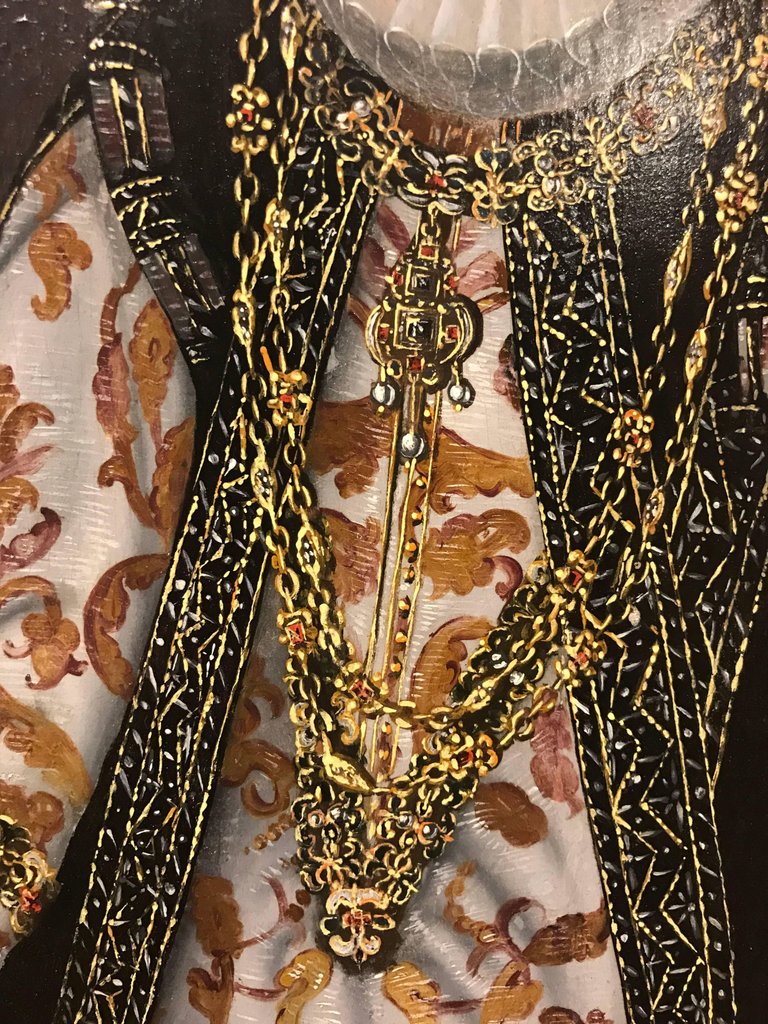FRENCH, 16th Century
Elizabethan Lady
c.1580
oil on panel
16 x 11 ½ inches
21 x 16 ¾ inches, inc. frame
Price: Price on Application
Provenance:
Christie's Paris, 21st of June 2011, lot 54
The Elizabethan era is the epoch in the Tudor period of the history of England during the reign of Queen Elizabeth I. Historians often depict it as the golden age in English history. The symbol of Britannia was first used in 1572, and often thereafter, to mark the Elizabethan age as a renaissance that inspired national pride through classical ideals, international expansion, and naval triumph over the Spanish – at the time, a rival kingdom much hated by the people of the land. In terms of the entire century, the historian John Guy (1988) argues that "England was economically healthier, more expansive, and more optimistic under the Tudors" than at any time in a thousand years.
The Role of Elizabethan Women - Education - The Nobility
The Elizabethan era brought the Renaissance, new thinking to England. Elizabethan women from wealthy and noble families were sometimes allowed the privilege of an education. The girls of Noble birth were invariably taught by tutors at home and Elizabethan women were taught from the age of five, or even younger. Various languages were taught including Latin, Italian, Greek and French. Music and dancing skills were essential for Elizabethan women. Elizabethan women were not allowed to go to university. Elizabethan women would have had to learn how to govern a household and become skilled in all housewifely duties. Her education would have been purely of the domestic nature in preparation for the only real career option for a girl - marriage! Single Elizabethan women were sometimes looked upon with suspicion. It was often the single women who were thought to be witches by their neighbours. All Elizabethan women would be expected to marry, and would be dependant on her male relatives throughout her life.
The Role of Unmarried Elizabethan Women in Society
At one time single women might spend their lives in a convent or nunnery but due to the dissolution of the monasteries, this was no longer an option. The only alternative to marriage for Elizabethan women from the lower classes was therefore domestic service. The married state was seen as highly desirable by all women of the lower classes. With parental permission it was legal for Elizabethan girls to marry at 12 although it was not usual for marriages at such young ages.
The Role of Elizabethan Women in Marriage
Elizabethan women were expected to bring a dowry to the marriage. A dowry was an amount of money, goods, and property that the bride would bring to the marriage. It was also referred to as her marriage portion. After marriage Elizabethan women were expected to run the households and provide children. Large families were the norm as the mortality rate for children and babies was so high. Many Elizabethan woman made arrangement for the care of their children in case they themselves died during childbirth.
The Role of Elizabethan Women in Society
Elizabethan women were raised to believe that they were inferior to men. The Church believed this and quoted the Bible in order to ensure the continued adherence to this principle. The protestant leader John Knox wrote: "Women in her greatest perfection was made to serve and obey man".
Elizabethan Woman were totally dominated by the male members of their family. They were expected to instantly obey not only their father but also their brothers and any other male members of the family. The punishment for disobey was the whipping stool - the Elizabethan girls were beaten into submission and disobedience was seen as a crime against their religion. Elizabethan Women could not be heirs to their father's titles. All titles would pass from father to son or brother to brother, depending on the circumstances. The only exception was the monarchy.
The Roles of Famous Elizabethan Women in Society
Queen Elizabeth I 1533-1603 - never married. An independent and dominant woman who would not share her throne with a man. She would have also been required to show total obedience to her husband Lettice Knollys 1540-1634 - Lady in Waiting to Queen Elizabeth - married the Queen's favorite, Robert Dudley, Earl of Leicester, in secret.
Mary Sidney Herbert, Countess of Pembroke - 1561-1621 referred to as the Swan of Avon. The second most important woman in England next to the Queen
Amy Robsart - Robert Dudley's first wife who died in mysterious circumstances
Kat Ashley - Faithful servant of Queen Elizabeth from a small, neglected child to the most powerful woman in England
Mary Queen of Scots 1542-1587 - Elizabeth's cousin who was kept prisonner in England until her execution for treason - conspired with Roman Catholics culminating in the Babington Plot
The Four Mary's - the Ladies in Waiting to Mary Queen of Scots - Mary Beaton, Mary Seaton, Mary Fleming and Mary Livingstone
Levina Teerlinc - female painter of the Elizabethan era







